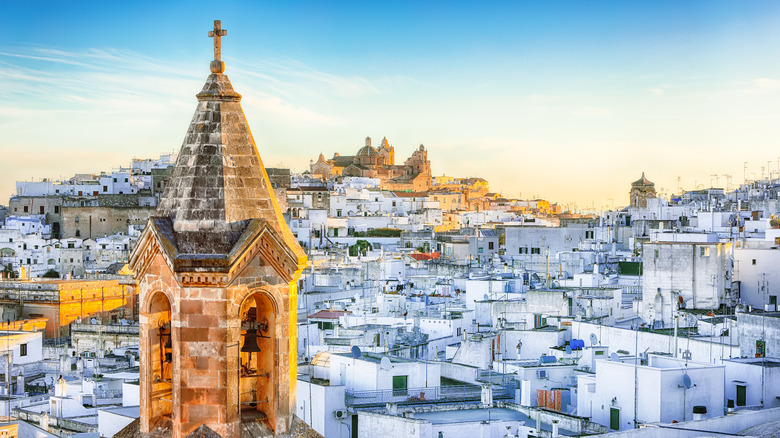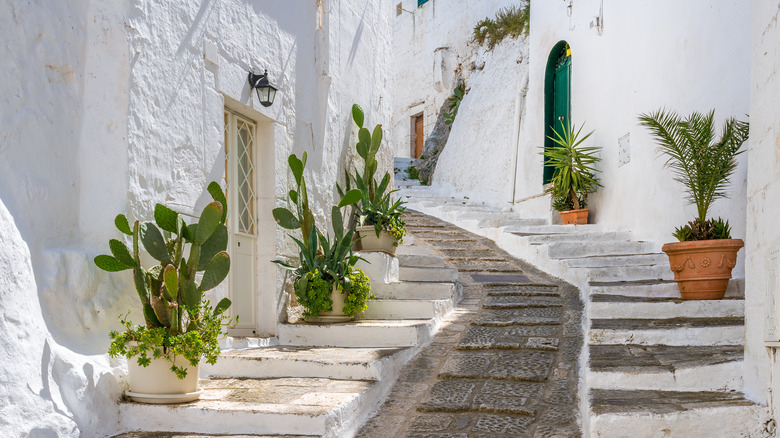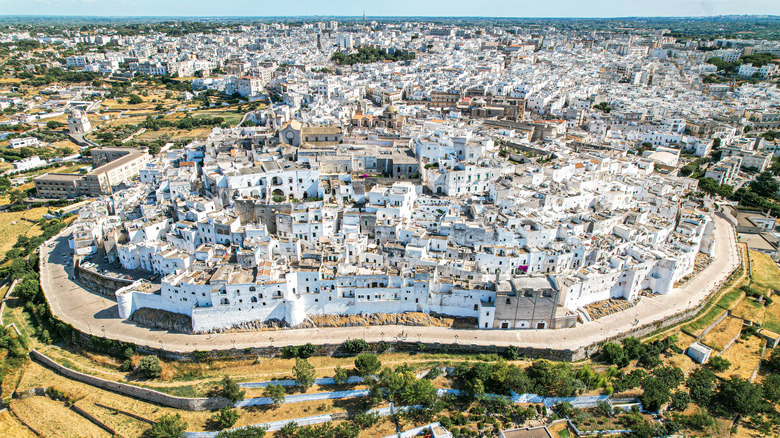Visit This Underrated Italian Hilltop For A Fun Small Town Vacation
Imagine yourself in a city on a hill in Italy. Around you are tiny streets that wind their way around the city, haphazardly, it seems. The local olive oil is abundant, the view of the Adriatic Sea 5 miles away is a turquoise gem, and the local cathedral crowns the entire thing. You can walk along the old walls and admire the whitewashing on the buildings, which some people believe helped stave off the plague. The city you're in is Ostuni, in the Puglia region of Italy, about halfway down the back of the Italian boot. In Italian, it's known as La Città Bianca, or the white city. The shining buildings are decorated with colorful shutters and doors, with pots of flowers everywhere. It looks like it came right out of a fairy tale.
This hidden gem of a city, founded around 600 B.C., produces 40% of the olive oil made in Italy, and this olive oil comes from some incredibly old trees. Let's explore Ostuni, Italy, and its treasures and check out what to see and do in this lovely place.
All about Ostuni, Italy
Ostuni is full of small alleyways and twisty roads. You can park at the bottom of the hill and walk up its steep walkways. This is a walking city, though you can take a tuk-tuk tour (a tuk-tuk is a cab set on a three-wheeled cart). Ostuni's streets tend to meander, so while it's probably a good idea to bring a map, just wandering around and discovering local craftsmen and little boutiques can also be a fun adventure. If you're okay with a bit of a climb, you can actually walk along parts of the old city walls for some picturesque views.
There are also walking tours you can take, as well as olive oil tasting tours, and the latter is an activity that you really must try. Some of the olive trees here are hundreds of years old, and some are even said to be over 1,000! However, you don't need to take a tour to see the whitewashed buildings. The practice of whitewashing took off during the plague that struck the area in the 17th century. The whitewash, made from limestone and water, reflected the sun and kept away the heat. But during the plague, places that were whitewashed seemed to have fewer deaths. Anecdotal as this may be, the calcium carbonate of the limestone whitewash (limestone is very common in the area) can combat bacteria, even if they didn't know that at the time. Plus, it's just beautiful to look at.
What to see in Ostuni, Italy
You can't see Ostuni without visiting the Cattedrale di Santa Maria Assunta. This late Gothic cathedral is in the Piazza Beato Giovanni Paolo II and was completed in 1495. It replaced a 13th-century Romanesque church after a 1456 earthquake, which itself replaced an 11th-century Orthodox church. The rose window in the front looks like it was created from lace instead of stone.
Then there's the Scoppa Arch, which once allowed people to cross from the church's duomo (dome) to the seminary. It was originally made of wood but was remade with stone after a 1743 earthquake. If you want a glimpse of exactly how long people have lived in the area, visit the Museo de Civiltà Preclassiche, which houses the roughly 26,000-year-old skeleton of a pregnant woman, now called Delia. There's also the Museo Diocesano di Ostuni, set in a building that used to house bishops but is now full of art and artifacts uncovered in the area.
While you're walking the city, visit its Centro Storico (or old town area) and the main street, Via Cattedrale. It runs from the Piazza della Libertà at the bottom of the hill to the cathedral at the top. It's full of shops, including lots of places to pick up some local olive oil and wine. Make sure to try the taralli (breadstick rings) and lupini (pickled yellow beans). If you visit on Saturday, you can shop at the Mercato del Sabato market on the Via Nino Sansone.


